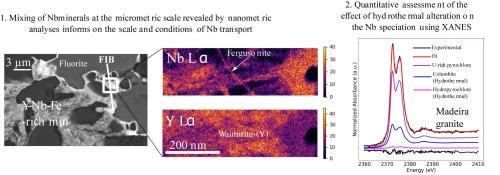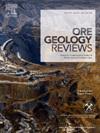Hydrothermal niobium (Nb) mineralization and mobilization in the world-class Madeira Sn-Nb-Ta granitic deposit (Amazonas, Brazil)
IF 3.2
2区 地球科学
Q1 GEOLOGY
引用次数: 0
Abstract
The Madeira deposit is a world-class tin (Sn) deposit characterized by a unique mineralogical assemblage composed of a massive cryolite (NaAlF3) deposit associated with economically important metals like Nb (0.20 wt% Nb2O5). Although hydrothermal alteration has long been recognized in the cryolite formation, its effects on the mineralization and mobility of Nb remain obscure. This study presents new data on the Nb mineralization of the Pitinga core and border albite-enriched granites provided by nanoscale and site-selective approaches, using transmission electron microscopy and synchrotron-radiation analyses. Pyrochlore is the main Nb ore mineral with three distinct compositional types (U-Pb, Pb-U and Y-bearing varieties). Hydrothermal processes lead to the extensive alteration of pyrochlore into columbite (later designated as columbitization) by a coupled dissolution-reprecipitation mechanism, which evidences the alterability of pyrochlore in a hydrothermal context. Nanoscale analyses of veins and reaction interfaces reveal the presence of additional Nb hosts including fergusonite-(Y), Nb-bearing uraninite and Nb-bearing coffinite which formed from the alteration of pyrochlore. The nature of the altered phases mainly depends on the composition of the parent pyrochlore. Their formation, occurring in absence of direct proximity with remaining pyrochlore, shows that Nb mobilization at macroscopic scale is possible in F-rich reducing fluids. Niobium L3-edge XANES spectroscopy on bulk samples representative of the different facies show that hydrothermal processes change the Nb mineralization by converting primary U-Pb-bearing pyrochlore into columbite and Pb-U/Y-bearing pyrochlores. The columbitization process of pyrochlore led to the increase of the Nb ore grade. Nonetheless, hydrothermal alteration modified Nb mineral liberation, thereby limiting the recovery of the full range of Nb host phases.

世界级马德拉硒铌钽花岗岩矿床(巴西亚马孙)中的热液铌(Nb)矿化和移动现象
马德拉矿床是世界级锡(Sn)矿床,具有独特的矿物组合特征,由块状冰晶石(NaAlF3)矿床组成,并伴生铌(0.20 wt% Nb2O5)等重要经济金属。虽然热液蚀变在冰晶石形成过程中早已得到确认,但其对铌的矿化和流动性的影响仍不明显。本研究利用透射电子显微镜和同步辐射分析,通过纳米尺度和位点选择方法,提供了有关 Pitinga 核心和边界富含白云石花岗岩铌矿化的新数据。焦绿泥石是主要的铌矿矿物,具有三种不同的成分类型(含 U-Pb、Pb-U 和 Y 的品种)。热液过程通过一种溶解-再沉淀耦合机制导致焦绿泥石广泛蚀变为铌铁矿(后被称为铌铁矿化),这证明了焦绿泥石在热液环境中的可变性。对矿脉和反应界面进行的纳米级分析表明,在辉绿岩的蚀变过程中还存在其他的铌母质,包括铁燧石(Y)、含铌铀矿石和含铌棺石。蚀变相的性质主要取决于母体辉绿岩的成分。它们的形成与剩余的火成岩没有直接关系,这表明在富含 F 的还原流体中可能存在宏观尺度的铌迁移。对代表不同岩相的块状样品进行的铌 L3-edge XANES 光谱分析表明,热液过程通过将原生含铀-铅辉绿岩转化为铌铁矿和含 Pb-U/Y 辉绿岩,改变了铌的矿化过程。辉绿岩的辉锑化过程导致铌矿品位上升。然而,热液蚀变改变了铌矿物的释放,从而限制了铌主相的全面回收。
本文章由计算机程序翻译,如有差异,请以英文原文为准。
求助全文
约1分钟内获得全文
求助全文
来源期刊

Ore Geology Reviews
地学-地质学
CiteScore
6.50
自引率
27.30%
发文量
546
审稿时长
22.9 weeks
期刊介绍:
Ore Geology Reviews aims to familiarize all earth scientists with recent advances in a number of interconnected disciplines related to the study of, and search for, ore deposits. The reviews range from brief to longer contributions, but the journal preferentially publishes manuscripts that fill the niche between the commonly shorter journal articles and the comprehensive book coverages, and thus has a special appeal to many authors and readers.
 求助内容:
求助内容: 应助结果提醒方式:
应助结果提醒方式:


